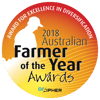
It is in everybody’s best interest to ensure that livestock are not under any unnecessary stress before, during or after they are transported.
Ensuring the welfare of livestock whilst they are being transported by land is a high priority for everyone in the industry.
There are various regulations and guidelines that ensure that everyone within the chain of responsibility take steps to certify that all animals that are being transported arrive at their destination without harm or are under any unnecessary stress.
Land transport can be stressful for animals, for this reason, the Australian Government have procedures in place that livestock owners, drivers, receivers and handlers must take to make sure that the livestock will be as comfortable as possible.
The length of the journey, the forecasted weather, water and food deprivation times, road conditions and terrain and the vehicle specifications will all play a role in how much stress is placed on the livestock. The species, class, age and condition of all animals must also be taken into consideration when planning journeys.

Planning:
Planning is everything. Livestock owners, drivers and freight companies have a duty of care when it comes to planning every journey. All people responsible for handling the livestock have a responsibility for the livestock’s welfare. This includes the persons' responsible for mustering and drafting before the journey has commenced.
Anyone who handles livestock must have sufficient experience or supervision in adequate animal handling and movement techniques.
This is to reduce the amount of stress placed on the livestock and to ensure their safety. All people involved in planning the journey must communicate effectively to make sure that the journey will go as smoothly as possible.
The supplier of the livestock have a responsibility to ensure that all of the livestock are fit to load. This means that they must be capable of making the entire duration of the journey. They are to provide feed and water so that the animals will not be off of food or water for too long. They also must provide suitable holding facilities to ensure the safe loading and unloading of livestock. Lastly, suppliers must provide the correct documentation for every one of the animals they intend to transport.

The Driver:
Truck drivers don't just drive. They have undertaken a lot of training and have gained sufficient experience when it comes to their trucks and equipment, as well as the livestock they are carting.
Before livestock are loaded drivers check their vehicle, trailers and equipment to ensure that it is in good working order. Drivers check their vehicles regularly to ensure that all faults are reported and repaired. This is so that no unnecessary harm comes to animals, themselves or anyone else on the road.
There are also chain of responsibility regulations is place to make certain that the maintenance of trucks, trailers and equipment meet the minimum standards required by law in Australia. This includes reporting and repairing faults as well as planning safe journeys.
Once the driver assures that all of the livestock are fit and healthy to load, they are safely and calmly loaded onto the certified livestock trailer.
Livestock trailers and equipment are designed to cause minimal stress or harm to any livestock onboard.
Once the livestock are loaded, the driver is responsible for their welfare until they reach their destination.
There are strict regulations regarding loading, unloading and travel procedures so that livestock are not loaded too tightly and are not crowded during the journey.
The driver will have a loading plan to make sure that livestock are not crowded, that species aren’t loaded together and that young animals are not in danger of being harmed.
Once the journey has commenced livestock are monitored during the entire length journey. If the maximum allowable time off water or fodder is reached the driver must stop and rest the livestock. They are unloaded into adequate facilities where they can rest and have access to water. This will already be considered in their travel plan.
The Road Transport Authority regularly stop livestock transport vehicles to make certain that their vehicles meet the Australian standards for heavy vehicles. Also, that they are not exceeding their mass limits and to inspect the welfare of the livestock onboard.
The National Heavy Vehicle Regulator have strict regulations in place to ensure that heavy vehicle operators are not driving too many hours and are not fatigued on our roads, contributing to not only the driver’s safety and the livestock on-board, but others on the road.

The driver will communicate with the receiver of the livestock to ensure that there are adequate unloading facilities for when they arrive at their destination. They also must certify that there will be fodder and water for the livestock for when they are unloaded.
Once the livestock reach their destination, the driver, with assistance from capable livestock handlers, must safely unload the livestock in a quiet and safe manner, making sure to cause the least amount of stress possible.
Finally, the livestock are provided with adequate water, fodder, time to rest and acclimatize to their new environment.

